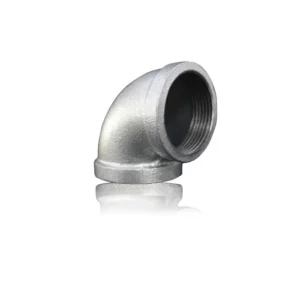Female malleable iron pipe fittings come in a variety of sizes and configurations to accommodate different piping systems and applications.
Common sizes and configurations available in the market include:
- Nipple: Nipples are short sections of pipe with threads on both ends, allowing for easy connection of two other fittings or pipes. They are available in various lengths.
- Elbow: Elbows are fittings with a 90-degree or 45-degree bend, allowing for changes in the direction of the piping. They come in different sizes and angles to suit specific needs.
- Tee: Tees have three openings and create a T-shaped junction in a pipe system. They are used to split or combine fluid flow and are available in various sizes.
- Cross: Cross fittings have four openings and create a cross-shaped junction in a piping system. They are used for more complex pipe routing and connections.
- Coupling: Couplings are used to join two pipes or fittings of the same size. They come in different lengths and are available with both female threads, male threads, or a combination of both.
- Reducer: Reducer fittings are used to connect pipes or fittings of different sizes. They typically have one end with larger female threads and the other end with smaller female threads.
- Union: Unions are used to provide a detachable connection point in a piping system. They consist of three parts: a female threaded end, a male threaded end, and a central nut that can be tightened or loosened to connect or disconnect the fitting.
- Cap: Caps are used to close the end of a pipe or fitting. Female Malleable Iron Pipe Fittings They are available in various sizes and are threaded on the inside.
- Plug: Plugs serve a similar purpose to caps but are typically used for closing off a male-threaded opening. They are threaded on the outside and can be inserted into the female-threaded opening.
- Bushings: Bushings are used to adapt a female-threaded fitting or pipe to a smaller size. They have female threads on one end and male threads on the other.
- Locknut: Locknuts are used to secure threaded fittings in place, preventing them from coming loose. They are typically used in conjunction with other fittings.
These are some of the common sizes and configurations of female malleable iron pipe fittings available in the market. The choice of fitting depends on the specific requirements of the piping system and the application it serves. It’s important to select the right size and configuration to ensure a secure and leak-free connection.
What are the advantages of using female malleable iron pipe fittings in plumbing and industrial applications?
Female malleable iron pipe fittings offer several advantages in plumbing and industrial applications, making them a popular choice for connecting and controlling fluid flow in various systems. Some of the key advantages of using female malleable iron pipe fittings include:
- Durability: Malleable iron fittings are known for their strength and durability. They can withstand high-pressure applications and are less prone to cracking or breaking compared to some other materials.
- Corrosion Resistance: Malleable iron fittings are often coated with a layer of zinc or other protective coatings to enhance their resistance to corrosion, making them suitable for a wide range of environments, including outdoor and corrosive settings.
- Temperature Resistance: They can handle a wide temperature range, making them suitable for both hot and cold applications, including in HVAC systems and steam piping.
- Versatility: These fittings come in a variety of sizes and configurations, allowing for flexibility in designing and configuring piping systems to suit specific needs.
- Leak Resistance: Female malleable iron pipe fittings are known for their reliable and leak-resistant connections when properly installed. The threaded connections create a tight seal, minimizing the risk of leaks.
- Easy Installation: They are relatively easy to install, especially when compared to welded or soldered connections. This can save time and labor costs in both plumbing and industrial applications.
- Removability: Unlike welded connections, malleable iron fittings are removable, allowing for system modifications, maintenance, or repairs without the need for cutting and re-welding.
- Longevity: When properly maintained, malleable iron fittings have a long service life, providing a cost-effective solution over the long term.
- Readily Available: These fittings are widely available in plumbing and industrial supply stores, making them easily accessible for various projects.
- Compatibility: Female malleable iron pipe fittings are compatible with a wide range of piping materials, including steel, galvanized steel, and other malleable iron components, offering versatility in system design.
- Pressure Ratings: They can handle high-pressure applications, which is particularly important in industrial settings where pressure is a critical factor.
- Wide Range of Applications: These fittings are suitable for various applications, including water supply, gas distribution, HVAC systems, fire protection, and industrial processes.
It’s important to note that while female malleable iron pipe fittings offer many advantages, they may not be the best choice for every application. Consider factors such as the environment, fluid being transported, and temperature range when selecting fittings to ensure they meet the specific needs of the project.
